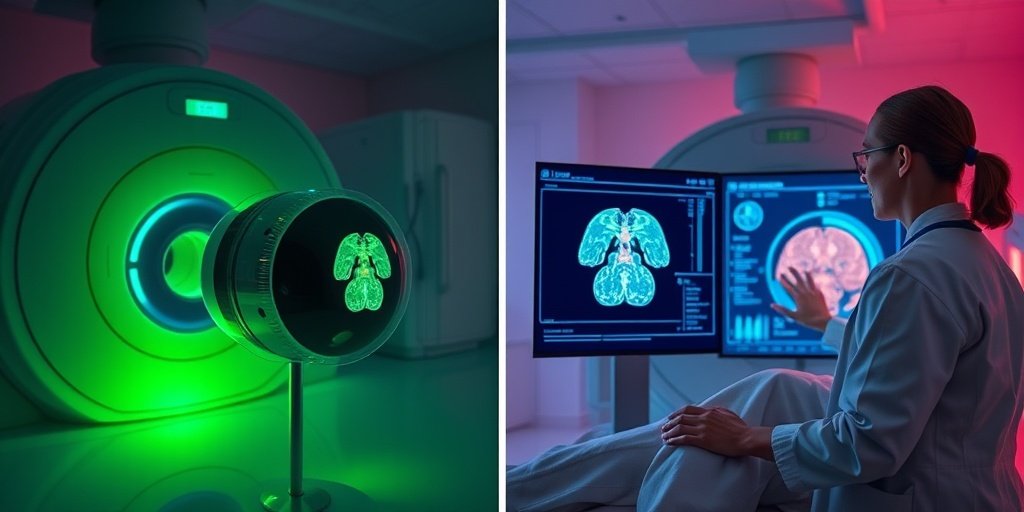⚡ Quick Summary
This study investigates the use of bimodal imaging probes that combine Magnetic Resonance (MR) and fluorescence (FL) imaging to enhance disease diagnosis and targeted therapy. The findings suggest that these probes significantly improve diagnostic precision and therapeutic outcomes across various diseases, including cancer and neurodegenerative disorders.
🔍 Key Details
- 🔬 Focus: Bimodal imaging probes for MR and FL imaging
- 🧬 Applications: Cancer, cardiovascular disorders, neurodegenerative diseases
- ⚙️ Methodologies: Ligand-based strategies, nanoparticle functionalization, molecularly imprinted polymers
- 📊 Evaluation: In vitro and in vivo assessments
🔑 Key Takeaways
- 🔍 Bimodal imaging combines the strengths of MR and FL for enhanced diagnostics.
- 💡 Improved targeting through advanced methodologies increases probe efficacy.
- 📈 Machine Learning and AI are integrated for better image analysis and diagnosis.
- 🏆 Superior spatial and temporal resolution achieved with these probes.
- 🌍 Potential to revolutionize our understanding of complex biological processes.
- 🧪 Study published in the International Journal of Nanomedicine.
- 📅 Citation: Gong T, et al. 2025; 20:9473-9503.

📚 Background
The field of molecular imaging has seen significant advancements, particularly in the context of complex diseases such as cancer and neurodegenerative disorders. Traditional imaging modalities often fall short in providing comprehensive insights into the biological environments of these diseases. The integration of multiple imaging techniques, particularly bimodal imaging, offers a promising solution to enhance diagnostic capabilities and therapeutic interventions.
🗒️ Study
This study delves into the design and application of bimodal imaging probes that utilize both Magnetic Resonance (MR) and fluorescence (FL) imaging. The researchers focused on methodologies to improve the targeting efficacy of these probes, employing strategies such as ligand-based approaches and nanoparticle functionalization. The study emphasizes the importance of achieving precise cellular imaging alongside in-depth tissue visualization.
📈 Results
The findings demonstrate that the bimodal probes achieve superior spatial and temporal resolution, allowing for accurate delineation of biological targets. The integration of advanced computational techniques, including Machine Learning and Artificial Intelligence, further enhances the diagnostic capabilities of these imaging probes, paving the way for improved therapeutic outcomes across various diseases.
🌍 Impact and Implications
The implications of this study are profound, as the integration of bimodal imaging probes could significantly advance our understanding of complex biological processes. By enhancing diagnostic precision and enabling targeted therapeutic interventions, these technologies hold the potential to transform healthcare practices, particularly in oncology and neurology. The future of disease diagnosis and treatment may very well hinge on the successful implementation of these innovative imaging strategies.
🔮 Conclusion
This research highlights the remarkable potential of bimodal imaging probes in enhancing disease diagnosis and targeted therapy. By combining the strengths of MR and FL imaging, healthcare professionals can achieve more precise diagnostics and better therapeutic outcomes. As we continue to explore the integration of advanced technologies like AI in healthcare, the future looks promising for improved patient care and outcomes.
💬 Your comments
What are your thoughts on the use of bimodal imaging in healthcare? We would love to hear your insights! 💬 Leave your comments below or connect with us on social media:
Implication of Bimodal Magnetic Resonance and Fluorescence Imaging Probes in Advanced Healthcare: Enhancing Disease Diagnosis and Targeted Therapy.
Abstract
Molecular imaging probes hold great promise in disease diagnostics and their therapeutic interventions. However, a single imaging modality sometimes lacks efficiency in all kinds of diseases. Conditions such as cancer, cardiovascular disorders, and neurodegenerative diseases critically require multimodal imaging to characterize complex biological environments accurately. Efficient targeting further enhances probe performance, improving diagnostic precision. This study explores the design rationale and application of bimodal probes designed for Magnetic Resonance (MR) and fluorescence (FL) imaging for their complementary strengths. MRI enables deep tissue visualization, while fluorescence offers high sensitivity and cellular-level resolution. Meticulous attention has been devoted to presenting methodologies aimed at improving the targeting efficacy of these probes. This involves the methodology to enhance targeting efficacy, including ligand-based strategies, nanoparticle functionalization, and molecularly imprinted polymers. The probes combine fluorescence for precise cellular imaging with MRI for in-depth tissue visualization, providing synergistic benefits that elevate their diagnostic potential. Moreover, we offer recent developments in Machine Learning and Artificial Intelligence-based computational approaches for image analysis, enabling more precise diagnosis across a range of diseases that may propel their diagnostic abilities for better therapeutic outcomes. Through systematic analysis and in vitro and in vivo evaluations, we demonstrate the ability of the probes to achieve superior spatial and temporal resolution, facilitating the accurate delineation of biological targets. The integration of these bimodal probes holds great promise for advancing our understanding of complex biological processes, enabling more precise diagnostics, and paving the way for targeted therapeutic interventions.
Author: [‘Gong T’, ‘Ullah Z’, ‘Roy S’, ‘Cheng C’, ‘Li M’, ‘Cheng J’, ‘Zhang Y’, ‘Guo B’, ‘Qiu Y’]
Journal: Int J Nanomedicine
Citation: Gong T, et al. Implication of Bimodal Magnetic Resonance and Fluorescence Imaging Probes in Advanced Healthcare: Enhancing Disease Diagnosis and Targeted Therapy. Implication of Bimodal Magnetic Resonance and Fluorescence Imaging Probes in Advanced Healthcare: Enhancing Disease Diagnosis and Targeted Therapy. 2025; 20:9473-9503. doi: 10.2147/IJN.S524454